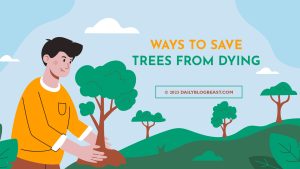Nature is a beautiful gift that God has given to us, so it is our responsibility to take care of nature to the best abilities.
There are many advantages to having trees in your yard. Here are a few of them. Besides providing shade for your home or company, these trees also give oxygen, wildlife habitat, and more. When it comes to having a healthy tree in your yard, there are numerous advantages to taking care of it regularly.
A variety of circumstances can bring on a tree’s demise. You’ll want to know the indicators of a dying tree and how to save a dying tree, whether it’s a disease, infestation, or poor care. You can save your tree before it dies if you know what symptoms to watch for and how to prevent it from dying.
10 Ways to Save Trees from Dying:
Spread Awareness about trees and nature
Know the Early Signs
Identify the Cause
Ensure Proper Sustenance
Use the Right Fertilizer and Test the Soil
Correct Watering Issues
Proper Mulching Technique
Proper pruning
Proper Sunlight
Provide the Right Soil

Spread Awareness about trees and nature:
Spreading awareness about trees and nature is one of the right ways to make people save the tree and take this concern seriously.
You may become involved by attending events, interacting with the media, posting on social media, putting up events to promote plant health, and even translating some of the IYPH materials into your own language. It’s up to plant health advocates in their nations to follow these tips in their efforts to promote plant health.
Know the early signs:
A landscape’s trees are a priceless treasure. These tall plants are not only beautiful, but they also provide shade and refuge for animals and other organisms. In certain cases, the death of a tree is visible, such as when the leaves turn brown in the summer or when wood-boring bugs ravage the limbs.
When a tree’s health is in question, it can be difficult to determine if it is dead or dying, especially if it is situated near a structure or residence. Falling branches from a dying tree can injure people and dogs, and your home or automobile may require extensive repairs if a branch breaks off and falls on them.
If you perceive any of these seven warning indications, it’s time to have your tree removed from the yard.
Identify the Cause:
If you discover a tree is dying, you’ll want to determine what’s causing it to succumb to its fate. A variety of factors can cause a tree’s demise. For example, the environment in which the tree grows may have an impact on its success.
Make an exertion to find out more about the habitat in which a certain kind of tree flourishes if you know its species. Is it dying because of something in its current environment? Insect and disease infestations should also be taken into account.
Insects may regard a diseased tree as a chance to infiltrate. Although not all insects infest trees, it is almost certain that your tree will have at least a few insects on it. Insects like pine beetles, emerald ash borers, and gypsy moths should be on your radar.
The death of a tree can also be caused by old age or catastrophic occurrences. Once you’ve figured out what’s causing the issue, you may start working on a solution.
Ensure Proper Sustenance:
How much water does your tree require to live? Do your homework on the exact species of tree you’re working with. How often and how much water does it require?
The tree may suffer if it receives too little or too much water. Give the tree a good two minutes of watering. Adjust the hose’s nozzle to avoid saturating the soil with too much water when doing so.
Drainage should be in place around the tree as well. Set your sprinkler system on a timer to water your tree if you can’t make it to your house or place of business frequently enough to do it yourself.
Use the Right Fertilizer and Test the Soil:
You may learn a lot about a tree’s health by analyzing the soil it grows in. If a soil test doesn’t reveal a specific nutrient, you’ll need to add it. Make careful to stay a safe distance from the tree when fertilising your grass.
Because you don’t want to over-fertilize the region, natural fertilizer is the best option.
Correct Watering Issues:
The most common cause of tree stress and early death is a lack of adequate hydration. Check the soil moisture levels as soon as you notice anything amiss with the look of your tree. You may need to conduct some deep root watering to ensure that the water reaches the tree’s roots. Overwatering can cause root flooding, which prevents your tree from absorbing oxygen.
Proper Mulching Technique:
Trees benefit from mulching. However, a tree can still be damaged by improperly applied mulch.
Mulch put around the tree’s base should not be overly thick. Mulching around a tree’s base should be kept to a minimum so that the roots may breathe. To avoid a plethora of additional tree issues, such as bacteria and fungal infections, insect infestations and rot, it is important to do this procedure. This is a wonderful resource for figuring out how much mulch to put down.
Proper Pruning:
Pruning a diseased tree correctly is also critical to its survival. As a side note, it is crucial to remember that pruning strategies for different types of trees vary. Because of this, you should consume some time performing research.
Remove any visible unhealthy spots from a healthy tree in order to do proper pruning.
To keep the illness from spreading further, make sure you remove the unhealthy branches from the tree and properly dispose of them.
You’ll need the correct kind of tree pruner for the job if you want to do it right. These tools are specifically intended for thicker branches that are difficult to reach with standard pruning tools. Fiskars’s 14-foot long extendable tree Pruner is a superb example of a tree pruner. You can easily trim branches up to 1 1/8 inches thick with this fantastic tool.
However, if you want a tree pruner that is both strong and automatic, the Sun Joe Telescopic Pole Saw is a great option. At 15 feet long and with an 8-inch cutting bar and chain, this Sun Joe pole saw can take down branches up to 7.25 inches in diameter with ease.
Proper Sunlight:
For the most part, trees require a lot of direct sunlight to thrive. A tree in complete shadow, which receives just two hours of sunshine each day, may have difficulty surviving since the lack of sunlight inhibits the photosynthetic process.
Like the majority of life on Earth, trees are photo periodically dependent. Photosynthesis, the process by which plants make the nutrients they need to live, is a process that necessitates exposure to the sun in some form for all plants.
Reach out to Local Arbor Tech:
Don’t vacillate between calling the arborists in your area when in doubt. Arborists are trained to distinguish between a fading tree and a dead one. They may also help you save a dying tree and bring it back to life by removing a dead one.
Since care for trees necessitates such attention to detail and nuance, you’re better off entrusting the task to the experts.

